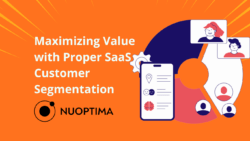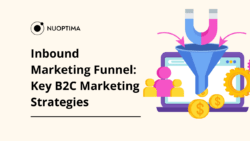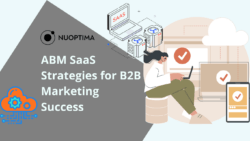Given the rapid growth of the SaaS industry, projected to exceed $262 billion in revenue in 2024, it’s clear that competition is fierce. [1] Rest assured, all of your competitors want to create a marketing plan for their SaaS company that will boost their revenue and pipeline. You can also be certain that many of them won’t achieve it.
If you want to be among the minority businesses that do achieve it, you have to create a scalable SaaS marketing plan. And we’re teaching you how!
The Ins and Outs of SaaS Marketing Plan
Before we give you the proven recipe for your marketing plan, you need to understand its elements and fundamentals, which are responsible for 90% of the results.
The first thing you need to understand is that, unlike traditional marketing strategies, a SaaS marketing plan focuses heavily on digital tactics and aligns closely with the customer’s journey from subscription to retention. This is especially true for micro SaaS products, which often target niche markets and require highly specific strategies.
Because of that, you need to put customers at the heart of everything you do. This strategy revolves around understanding and solving the customer’s problems, providing value through every interaction, and maintaining engagement to boost retention rates.
To amplify these efforts, leveraging specialized SaaS PR strategies can significantly boost your brand’s visibility and credibility in the market. For those looking to explore how a tailored PR approach can elevate your SaaS company, our SaaS PR Agency offers insights and expertise that align with your growth goals.
Remember, the goal is not just to attract leads but to nurture them into long-term users.
In the SaaS industry, we’ve witnessed the market changing rapidly, and most companies that overcome these changes enjoy even greater success. How adaptable your marketing plan is greatly contributes to its success. Agility in testing new strategies, leveraging data for decision-making, and pivoting based on SaaS metrics are all critical for staying ahead. Partnering with a specialized SaaS consulting agency can further enhance your ability to navigate these changes and ensure long-term growth, making your business more resilient to industry fluctuations. Incorporating ABM SaaS strategies can further enhance targeting and engagement, ensuring that marketing efforts are focused on high-value accounts. An essential component of your strategy should also be maximizing the efficiency of your paid campaigns, and partnering with a SaaS PPC agency can help you scale faster while optimizing your ad spend.
To further amplify your efforts and stay ahead in this competitive landscape, it’s essential to partner with a SaaS content marketing agency that understands the intricacies of the industry. By doing so, you can ensure that your content strategy aligns perfectly with your marketing goals.
Incorporating the right lead generation strategies is also key to a scalable SaaS marketing plan. For businesses looking to accelerate their growth, working with a SaaS lead generation agency can provide the tools and expertise needed to capture high-quality leads and drive long-term success.
With an abundance of analytics tools available, SaaS companies have the unique advantage of making informed decisions based on real-time data. This capability allows for fine-tuning marketing strategies to achieve maximum impact and SaaS ROI.
One key area where this data-driven approach shines is in SaaS email marketing, where personalized and targeted campaigns can significantly boost engagement and conversions. For more insights on how to optimize this channel, explore our comprehensive page on SaaS email marketing.
A SaaS marketing plan is not a standalone document but a part of the broader SaaS GTM strategy. It requires integration across various departments – sales, customer service, and product development – to create a unified approach to achieving business goals. For companies looking to enhance their online presence, implementing effective local SEO strategies can also play a crucial role.
Only when you are all on the same page can you create a plan designed for success. And we’re showing you how step-by-step:
How to Create a SaaS Marketing Plan? Step-by-Step Guide
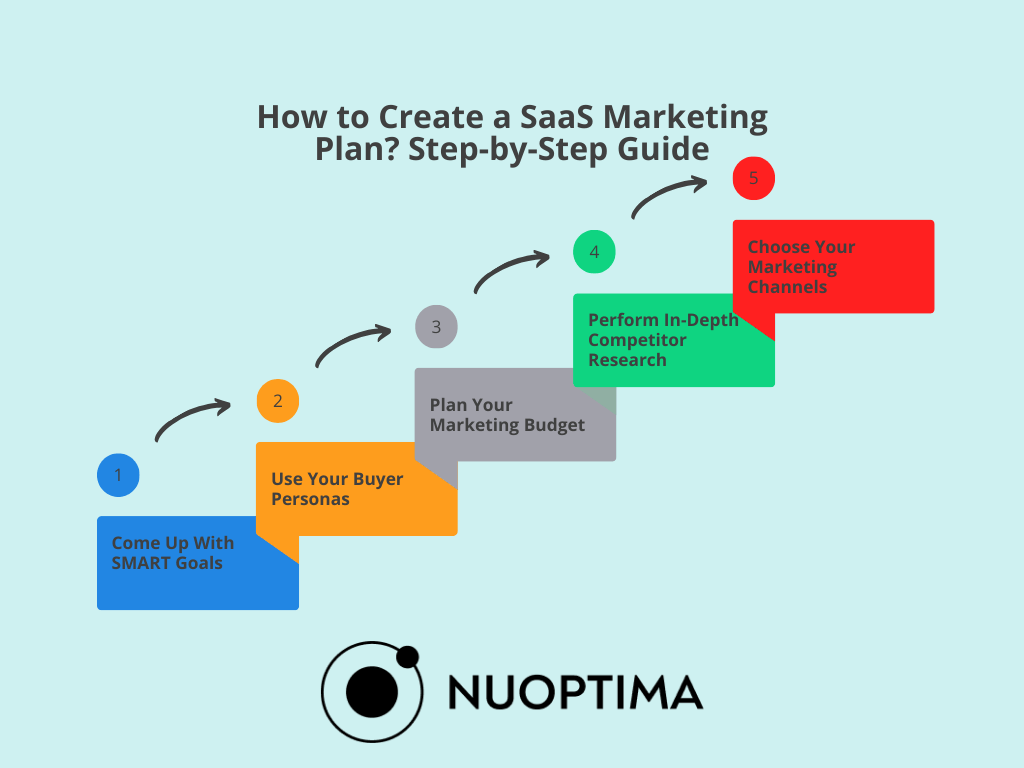
All aspects of your marketing plan should align with your business objectives, whether you’re developing a SaaS startup marketing plan or a plan for an already established business. And following a structured process will help you reach the right audience, nurture relationships, and accelerate revenue.
Having that in mind, let’s get to the first step, which actually is the most important one:
Come up with SMART Goals
A successful marketing plan for a SaaS company begins with setting clear and achievable goals.
We’ve already mentioned that a marketing plan isn’t only an effort from the marketing department. You need to sit down with customer support and product development teams to make sure the goals you set are achievable and relevant.
Using the SMART framework makes each goal Specific, Measurable, Achievable, Relevant, and Time-bound.
And here’s how to frame your marketing goals using this model:
| Specific | Measurable | Achievable | Relevant | Time-Bound |
| Outline exactly what you want to achieve. | Quantify progress with clear metrics. | Make sure goals are realistic based on your current resources and market conditions. | Align goals with broader business objectives. | Set deadlines to create urgency and measure progress. |
| “Increase qualified inbound leads from organic search by 20%.” | Instead of a vague goal like “Increase awareness,” opt for “Reach 10,000 visitors per month.” |
A 20% increase in leads might be feasible, but 200% could be a stretch. | If expanding into new markets is a priority, goals should reflect this direction. | “Achieve a 20% increase in leads within the next six months.” |
Measuring whether goals are achieved or not is where most SaaS businesses fail. Before you set a goal, you have to know how you’re going to measure it. It seems easy, but it’s actually harder than most people think.
Let’s take an example from the table above: “Increase qualified inbound leads from organic search by 20%.”
To measure this goal, you need to define what “qualified leads” means for your business and set up a Looker Studio or Google Analytics report that only measures conversions from organic traffic.
Setting SMART goals provides the framework for your marketing efforts, making it easier to allocate resources effectively and measure your progress. The next steps in this guide will help you build upon these goals to create a winning marketing plan.
In addition to setting clear goals, the way you communicate your value proposition plays a vital role in your marketing success. Collaborating with a SaaS copywriting agency can help you craft messaging that not only attracts but also converts your target audience.
Example
If your SMART goal is to increase customer acquisition by 25% in the next six months, you should target specific customer segments (e.g., startups or other tech companies), measure the progress using analytics tools, and make sure your SaaS marketing budget is enough for this challenge and that the goal is meaningful and contributes to overall company growth in the next six months.
Use Your Buyer Personas
Buyer personas aren’t just fictional profiles that represent your ideal customers; they provide insights into their behaviors, preferences, and pain points, making them extremely effective for powering your SaaS marketing plan. For those looking to deepen their understanding of buyer personas and other critical strategies, check out our list of SaaS books tailored for SaaS business founders.
If you are looking for some detailed insights, watch this video by NUOPTIMA’s Founder, Alexej Pikovsky, who explains what an ideal customer profile (ICP) is and why it is vital to have one before sharing his six-step guide to creating an ICP.
Let’s learn how you can use buyer personas effectively in your SaaS digital marketing strategy:
- Segment your audience based on characteristics like industry, company size, and role.
- Research each persona’s specific challenges and what drives their purchasing decisions. Are they looking to reduce costs, improve efficiency, or scale their business?
- Match each buyer persona and their challenges with your product’s features and how it solves their problems.
For example, if your buyer persona is a marketing manager at a small tech company, their challenges could include a limited budget, difficulty tracking campaign performance, and increasing customer acquisition.
But hey, your product provides advanced marketing analytics that integrates with existing CRM systems to offer a unified view of campaign performance. It includes customizable reports, automation features for lead scoring, and cost-effective campaign optimization tools to maximize ROI.
Once you want to target this buyer persona, you should focus your marketing efforts on strategies that will most likely convert them into loyal customers, ensuring a higher return on investment. Equipped with knowledge, you can create product-led content that successfully answers questions your buyer personas have while highlighting your product as a solution without being too salesy.
Example
Depending on your product features, you can develop personas for different roles, such as marketing manager or business owner, and create different types of content for each (differentiate based on topics and formats, e.g., ebooks, case studies, interactive product demos). Besides tailoring your content, you should also share it on channels they spend most of their time on (e.g., for marketing managers, that’s probably LinkedIn).
Plan Your Marketing Budget
If you had an infinite budget, you’d probably achieve all of your marketing goals sooner or later. But you don’t, do you?
That’s why your goals shouldn’t only be measurable and relevant, but also financially sustainable. Effective budgeting will help you allocate resources across different marketing channels, initiatives, B2B SaaS marketing campaigns, and tools.
Did you know that data-driven organizations are not only 23 times more likely to acquire customers but also six times as likely to retain customers? [2]
Because of that, the first thing you need to do is to asses historical data. If you had a $10,000 monhtly budget for marketing in the last year, it’s far-fetched to assume you’ll have $100,000 in the next month.
With a limited budget, you also need to make sure you get the most bang for your buck. If your SaaS company has previous marketing campaigns, analyze their performance to identify what worked well and what didn’t. Look at key metrics like customer acquisition cost (CAC), return on investment (ROI), and conversion rates to inform your budget allocation. Consider how the balance between SEO vs Google Ads can influence your marketing effectiveness and budget allocation.
Tools like Meta Business Suite, Google Ads Dashboard, Google Search Console, Google Analytics, Looker Studio, and specialized heat mapping and SaaS SEO tools will guide you to the right path.
Your budget should reflect your SMART goals. For instance, if expanding organic search traffic is a priority, allocate more funds to SaaS SEO and content creation.
Use insights from your buyer personas and historical data to determine which marketing channels deliver the best results. Whether it’s PPC, email marketing, or social media, focus your spending where you see the highest engagement and conversions.
Pro tip: Set aside a portion of your budget for testing new strategies and optimizing campaigns. With this tactic, you can experiment with different content formats, ad variations, and channels without risking your primary campaigns.
Example
If you took the time to analyze historical data, you might discover that LinkedIn ads generate higher-quality leads than Facebook ads. Your sales team can also help you determine which channels acquire the best customers. Once you get these insights, you can shift your budget towards LinkedIn and improve your ROI while lowering customer acquisition costs.
For businesses seeking expert guidance in optimizing LinkedIn ad campaigns to maximize lead quality, partnering with a specialized LinkedIn Ads agency can provide the strategic support needed to achieve superior results.
Perform In-Depth Competitor Research
Understanding competitors’ strategies helps you identify gaps, differentiate your offerings, and refine your positioning. This is extremely important if you want your marketing plan to actually impact your bottom line.
So, why not also check out this other YouTube video from Alexej Pikovsky to help you get a better understanding?
To fill market gaps your competitors haven’t thought about yet, you first need to identify your main competitors. These can be direct competitors offering similar SaaS solutions or indirect ones solving similar problems in different ways.
How do they position their product? Look for their value propositions, messaging, tone of voice, type of content they create and channels they use to reach their and your target audience.
Use tools like SEMrush or Ahrefs to analyze competitors’ keyword strategies for both paid and organic search. Look at their ad copy, landing pages, and backlink profiles to uncover opportunities for your campaigns.
Don’t forget that customer reviews can reveal competitors’ strengths but also weaknesses. Check platforms like G2, Capterra, and social media for recurring praise or complaints to understand what resonates or frustrates customers.
And last but not least, study the SaaS pricing models and feature sets competitors offer. Understanding how their pricing compares to yours can help refine your own pricing strategy and identify potential upsell opportunities.
Example
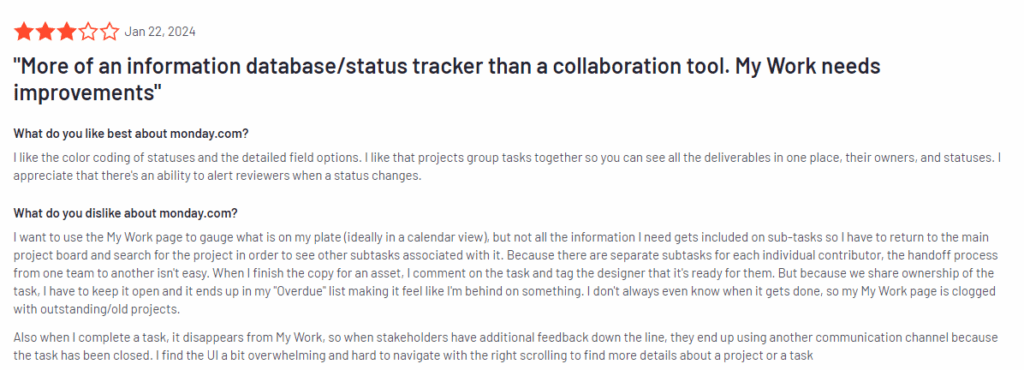
For example, if you want to market project management software, you could notice that most of your competitors lack customizable automation features. Based on customer reviews, you know there is a market for that. Having that in mind, you can collaborate with your product team to develop that feature and emphasize automation in your content, messaging, and all of your channels.
Choose Your Marketing Channels
Selecting the right marketing channels will help you effectively reach your target audience and achieve your B2B SaaS marketing goals. Each channel has its unique advantages and caters to different customer behaviors, so you should tailor your strategy to align with your buyer personas and business objectives. Incorporating SaaS account-based marketing into your strategy can refine your approach by focusing on high-value accounts, further enhancing your reach alongside SaaS affiliate marketing to drive targeted traffic to your offerings.
Again, for a better understanding, explore this YouTube video where Alexej Pikovsky shares the top 10 SaaS growth strategies to help your SaaS business gain a decided edge over the competition.
If your SaaS solution targets B2B professionals, LinkedIn will certainly be a priority channel for getting MQLs, but email marketing will be better for nurturing those leads. Building a personal brand on LinkedIn can enhance your engagement and credibility, making it easier to attract potential clients. It’s all about the SaaS customer journey and what your audience expects at each stage. If you want to inform existing customers about new features, you probably won’t use a TikTok video to achieve that.
Instead, you can use a TikTok video to entice new leads to sign up while informing existing customers about new features through an email newsletter.
Channels like content marketing, SEO, and organic social media are there to provide value through educational resources, blogs, and social posts that naturally attract and nurture potential leads.
Plus, content marketing campaigns are 62% cheaper than other types of campaigns, while 74% of companies reported that it’s one of the best channels for lead generation. [3] This makes it a no-brainer for a SaaS company like yours to invest part of its budget in this effective channel.
After they’ve engaged with your content, use retargeting ads on social media and display networks to engage those who are interested but haven’t converted yet.
Example

MarketFinance, a leading fintech company, partnered with Nuoptima during the COVID-19 pandemic to make the most out of their SEO and content marketing strategies.
SEO and content marketing proved to be amazing channels, as the collaboration resulted in a 250% increase in organic traffic and a traffic value of $81,000. Talk about high-quality leads!
By working closely with MarketFinance’s marketing team, Nuoptima predicted emerging search trends and provided high-quality SEO content that helped the company launch new financial products like bounce-back loans.
Test & Optimization
Nobody gets it right on their first try! That’s where testing and re-optimization come into play.
Testing lets you discover what resonates most with your audience, while optimization allows you to refine your campaigns for the best results.
Sometimes, small tweaks are all you need. Because of that, you should identify marketing channels and strategies where small tweaks could significantly impact performance. For example, changes to email subject lines or SaaS landing page headlines can lead to higher click-through rates.
You can also do A/B tests from the start by creating two versions of the same marketing asset, differing only in one element (e.g., CTA button color, ad copy, or email subject line). Monitor which version performs better and implement changes accordingly.
The content is also not a one-and-done job. For instance, if blog posts with lists or guides consistently attract more traffic, by analying the data you will know that creating similar content will get better results.
Example

The success of Microminder’s SEO strategy hinged on continuous monitoring of keyword rankings, organic traffic, and conversion rates. Nuoptima’s team used data to assess improvements in ranking, traffic, and the effectiveness of landing pages, ensuring that the SEO strategy aligned with business goals.
They tracked keyword rankings to increase the number of pages appearing in the top 100 results and monitored organic traffic value, which grew from $106 to $14,601.
They also tested different content strategies and optimized landing pages to improve their search engine visibility and conversion efficiency. They identified that Microminder lacked service-specific landing pages and optimized them for search intent and CRO. The team tested various content structures, CTAs, and technical content formats to maximize engagement and lead generation, leading to 20 high-quality monthly leads.
Expert Tips for Marketing Plan for SaaS Company
Insights from seasoned experts can transform your SaaS marketing plan into a powerful engine for growth. We spoke with the SEO Lead at Nuoptima and the Head of Clients and Business Development to bring you these practical tips:
Prioritize SEO Early
Adrijana Palatinus, SEO Lead at Nuoptima, emphasizes that a strong SEO strategy is foundational for success.
“Start with comprehensive keyword research to identify terms your potential clients use. We use Ahrefs to do this. Optimize your website’s structure and content for these terms to improve your organic search visibility. Technical SEO is also important; your site should be fast, mobile-responsive, and easy to navigate. This will help search engines rank you higher and lead to a better user experience.”
Develop Evergreen Content
“Content that answers common questions or provides lasting value will consistently attract organic traffic,” she advises. “Create a blog, knowledge base, or resource hub with well-structured guides, whitepapers, and tutorials. Focus on addressing problems your software solves to position your SaaS product as the go-to solution.”
Personalize Client Outreach
The Head of Clients and Business Development, George Ilich, underscores the importance of personalizing your approach.
“Data-backed segmentation is vital. Group clients based on their needs, industry, or company size. Craft messaging that directly addresses their pain points and objectives, demonstrating how your SaaS solution can help them achieve their goals.”
Leverage Marketing Automation
“Automation simplifies segmentation and allows for timely follow-up with leads,” he explains. “Create automated workflows for email campaigns, lead scoring, and nurturing sequences. This improves efficiency communication with potential customers.”
Support Clients Post-Sale
“The post-sale is just as important,” he emphasizes. “Offer SaaS onboarding resources, regular check-ins, and educational webinars. Satisfied clients who receive excellent customer service are more likely to renew and refer your SaaS solution.”
Conclusion
If you do it right, the SaaS marketing plan you create following these steps will yield results in the years to come.
But to truly increase your chances of success, you need to sit down with your colleagues from customer success, sales, and product development teams and align your goals. Don’t go overboard; start small with 2 to 3 goals created with the SMART framework.
Once you get into the nitty gritty of buyer personas and budget, you’ll have a better picture of whether those goals are attainable or not. You might need to revisit, but remember that practice makes it perfect.
In-depth competitor research and the selection of the best marketing channels will guide you on the right path to find your competitive edge and meet your ideal customers where they are. Once you’ve gone through all these steps, don’t pour the entire budget into your campaigns immediately. Additionally, leveraging the right advertising platforms, such as partnering with a reliable Facebook ads agency, can help you scale your efforts and reach your target audience effectively.
Once again, it’s important to start small, track performance, and get data to inform your future strategy. Nothing beats real-life insights from your potential customers. You’ll probably discover that some of your campaigns work better than others, and it would be a smart move to invest more effort and resources into those particular campaigns.
And if you don’t want just any leads but the highest quality leads you could dream of, a specialized B2B SaaS SEO agency will help you achieve these results. We already mentioned the amazing results we achieved with our clients Microminder and MarketFinance, and we can guarantee you’ll see the ROI. How can we say this?
Our expert team understands the nuances of the SaaS industry and is committed to creating a marketing plan that maximizes the growth potential of your SaaS company.
Book a call with our experts, and we’ll help you set up SMART goals you’ll achieve in the shortest time period with a budget that won’t break the bank.
FAQ
SaaS marketing is the promotion of SaaS products, focusing on acquiring new customers and retaining existing ones through digital channels, personalized messaging, and scalable strategies.
To create a marketing plan for SaaS, set SMART goals, use buyer personas, plan your budget, conduct competitor research, select marketing channels, track performance, and continuously test and optimize your strategies.
Key elements of a SaaS marketing strategy include customer segmentation, content marketing, SEO, paid advertising, email marketing, customer onboarding, and retention programs.
SaaS content marketing involves creating and sharing valuable content like blogs, webinars, and case studies that attract, educate, and nurture potential customers throughout the sales funnel.
SaaS marketing is different because it prioritizes customer retention and engagement alongside acquisition, often relying heavily on digital strategies, freemium models, and subscription-based revenue.

